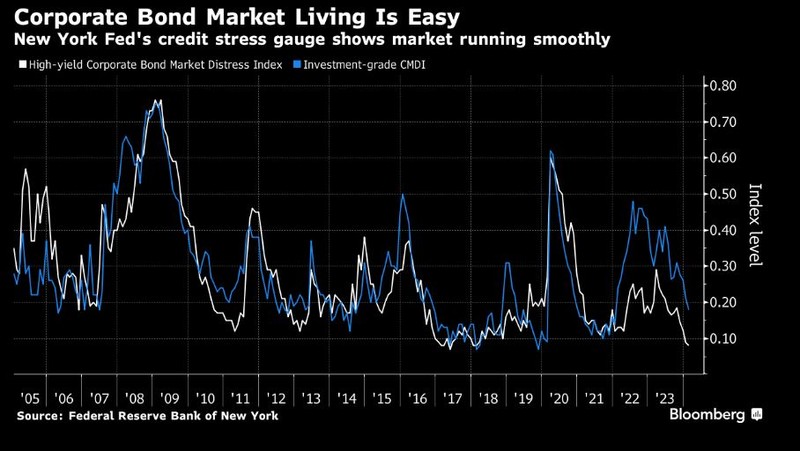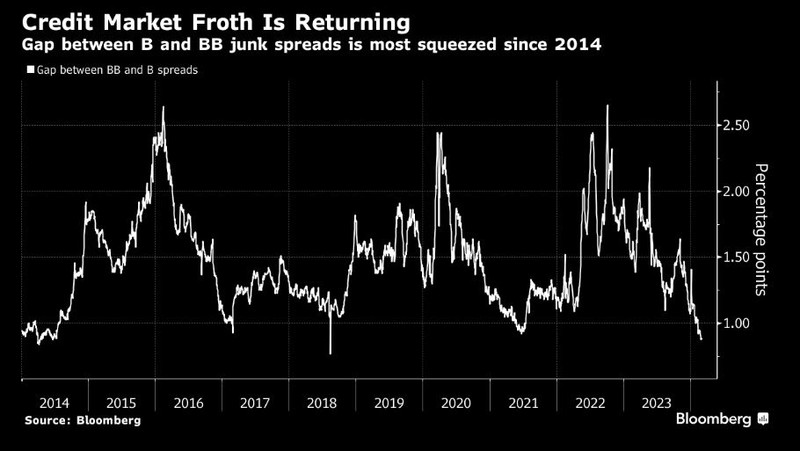Bloomberg First Word
March 14, 2024
This article was written by James Crombie. It appeared first on the Bloomberg Terminal.
Record levels of corporate bond issuance at ever-tighter pricing highlight a glut of cash in US credit markets that will only balloon when the Federal Reserve starts easing. Growing signs of froth would support calls for tighter — not easier — policy to nip excessive leverage in the bud.
- Higher rates will not impede access to capital for the vast majority of US companies, which are selling debt at the fastest pace ever, despite paying much more than they’d got used to over the last decade. Capital markets are wide open, risk premia are razor thin — and the only things breaking are businesses the economy can probably live without.
- When the Fed embarked two years ago on its most aggressive tightening campaign in decades, fears that the flow of credit could be disrupted were seen as a moderating influence on policymakers. A high-grade US bond spread above 150 bps was viewed as a level that might prompt the Fed to take its foot off the accelerator — but that level has barely been tested.

- Credit markets took swift and steep tightening with ease. They also sailed through wars, geopolitical volatility and a banking crisis that claimed a global systemically important bank — and significant corporate credit underwriter — Credit Suisse.
- That suggests central bankers could have been even bolder. Companies rated all the way down to single B had no trouble raising capital, while the parade of defaulters and bankruptcy filers was largely characterized by unsustainable capital structures whose life support flipped off when the free-money era ended. The New York Fed’s own gauge of credit stress, introduced three years ago to track primary and secondary liquidity, shows junk-bond dislocations close to an all-time low.
- However, there are now growing signs of froth, which will only worsen if money gets easier. First, demand for corporate debt has been massive, squeezing spreads to multi-year lows, crushing new issue concessions and dramatically inflating order books.
- The fact that there aren’t enough bonds to go around — even at record levels of issuance — has pushed yield chasers to the rapidly expanding private market and into structured products like collateralized loan obligations. A demand/supply imbalance in public markets, exacerbated by direct lending, masks growing junk-bond risks.
- In addition, there’s a distinct lack of discrimination between borrower quality at the low end of junk — another sign that there’s too much cash in the system. The gap between spreads on BB and B rated bonds is the tightest since 2014 (ignoring what looks like a fat-finger kink in our data in 2018). At 88 bps, the difference far below the 10-year average closer to 150 bps.

- Issuers are taking advantage, repricing a record amount of loans at the start of the year and reviving structures like pay-in-kind and second lien that only work when credit markets are still dancing. That in turn supports leveraged buyouts, which are just getting started as the money becomes easier.
- Higher funding costs and declining earnings put pressure on balance sheets, tipping the weakest borrowers over the edge. But most companies have adjusted to this new reality without much difficulty. And credit markets have reached an equilibrium where borrowing costs aren’t too high, yet all-in yields look very attractive to buyers on an historical basis.
- There’s always a risk that a deeper-than-expected recession causes a dramatic repricing in spreads and weeds out more weak borrowers. Volatility caused by this year’s US presidential election may also make it harder for companies to raise new debt.
- But excess cash sloshing through corporate debt markets is a clear warning to policymakers pondering their next move. Buyers are waiting to pounce on any easing, emboldened by the fact that credit did not crack when base rates soared — and reassured by the backstop the Fed put in place during the pandemic.
- Froth creeping back into credit markets bolsters the case for the Fed to hold for longer — and possibly even to hike. And credit’s set up for severe disappointment after pricing in half a dozen 2024 rate cuts late last year.